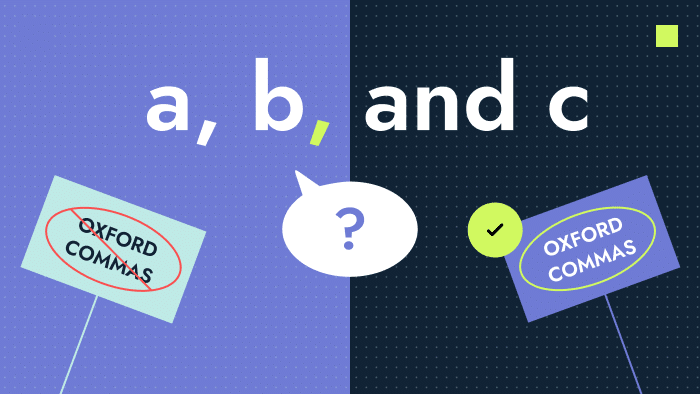Using or not the Oxford comma – that controversial final comma in a serial list – is all a matter of writing style and preference. The choice between embracing or ditching this punctuation mark in B2B copywriting can tell you a lot about a brand’s tone and voice, though.
So what do you think of the Oxford comma?
This is, in fact, one of the job interview questions I ask candidates when hiring new B2B content writers for our team. I want to find out if they know what the Oxford comma is. You can’t call yourself a professional writer if you are unable to discuss the basics of punctuation. Interestingly, most candidates feel compelled to say the Oxford comma must be used, but there is no right or wrong answer here.
Writing style guides such as Chicago, MLA and APA recommend its use to prevent ambiguity, but others — like the AP Stylebook — consider it unnecessary. When it comes to B2B content writing, you need to follow your brand book — a document that should be tailored to the tone and voice you want to convey. If you are building a writing style guide for your B2B company, and want to make an informed decision about the use of the Oxford comma, this guide is for you.
Discover who uses this controversial punctuation mark and why.
What is the Oxford comma rule?
The Oxford comma – also known as the serial comma — is a comma used immediately before a coordinating conjunction (and, or, nor) in a list of 3 or more items.
So how to use the Oxford comma?
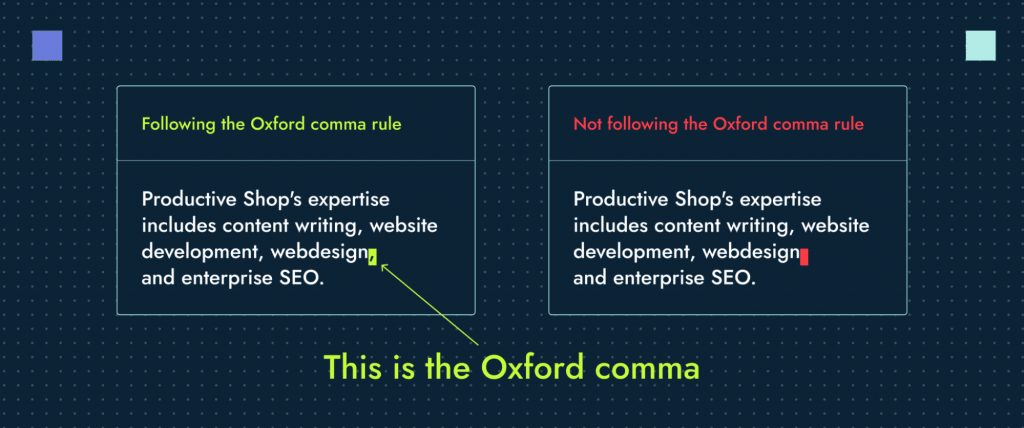
The argument pro Oxford comma
The proponents of the Oxford comma make the valid point that it helps to prevent ambiguity. For example, when writing lists of items, using the Oxford comma can make it clear which items are separate and which are combined.
Consider these sentences:
- My role models are my parents, John, and Mary.
- My role models are my parents, John and Mary.
In the first sentence, it’s clear that, in addition to the parents, John and Mary are also role models. In the second sentence, it’s unclear if I’m referring to John, Mary and my parents or if John and Mary are the names of my parents. Using the serial comma would resolve the ambiguity, but you could also simply rewrite the sentence to avoid confusion: “My role models are John, Mary and my parents.”
Ambiguous writing leads to misinterpretations — and the dispute can end up in the courts. You might remember what is known as the Oxford lawsuit, a reference to a legal case in Maine, where a group of delivery drivers sued their employer over a dispute involving the use of the Oxford comma in a state overtime law.
The drivers claimed that the lack of a comma in the law’s list of exemptions from overtime pay was causing confusion and leading to them being denied overtime pay. The company ended up settling the case.
The argument against Oxford comma
Those against the Oxford comma make the case that it’s often unnecessary, distracting and even redundant, especially in simple sentences, because the conjunction already denotes a separate entity. In printed journalism, for example, space is often limited, and every character and punctuation mark counts, so omitting the Oxford comma saves space and makes articles easier to read.
If a comma doesn’t help make clear what is being said, don’t use it. But: If the comma is needed for accuracy or clarity, then be sure to use it. That includes the Oxford comma, when you need it for clarity. #APStyleChat (7/9)
— APStylebook (@APStylebook) October 1, 2018
Anti-Oxford comma proponents argue that you could improve clarity simply by rephrasing sentences. Another argument is that the serial comma itself could also produce ambiguity.
- My role models are my dad, John, and Mary.
- My role models are my dad, John and Mary.
With example 2, it’s clear I’m referring to 3 people, but with example 1, it’s unclear if John is the name of my dad or if I’m referring to different people. But again, rephrasing the sentence would solve the problem: “My role models are my dad, Mary, and John.”
How to decide whether or not to use Oxford commas
When we are putting together B2B writing guidelines for our clients, we first look at the patterns on their websites and sales decks. Most of the time the writing is inconsistent, with pages in both title case and sentence case; punctuation and hyphenation are left at the mercy of the writer. We then advise on the importance of sticking to one style. Perception is important, and you don’t want to be perceived as inconsistent or sloppy with your punctuation. Having established content guidelines is also especially helpful if you are working with a diverse team of B2B freelance writers.
When asked about their top content challenges, 16% of the surveyed marketers in The State of Content Marketing Report mentioned the difficulty in maintaining a consistent tone of voice across all channels. The study reveals that 78% of high-scoring posts are consistent with their tone of voice – in other words, they don’t have sentences that are too casual or formal in relation to their target tone.
If you want a more formal style, we recommend using the Oxford comma. But you should ditch it if you want to make your copy more approachable.

Oxford comma memes aside, more formal styles indeed favor this punctuation. Academic writing is all in for the Oxford comma. The style guide of the U.S. government also encourages its use. But you won’t see the Oxford comma on the news because journalists stay away from it.
Who uses the Oxford comma
Here’s the breakdown of the best-known style guides in North America:
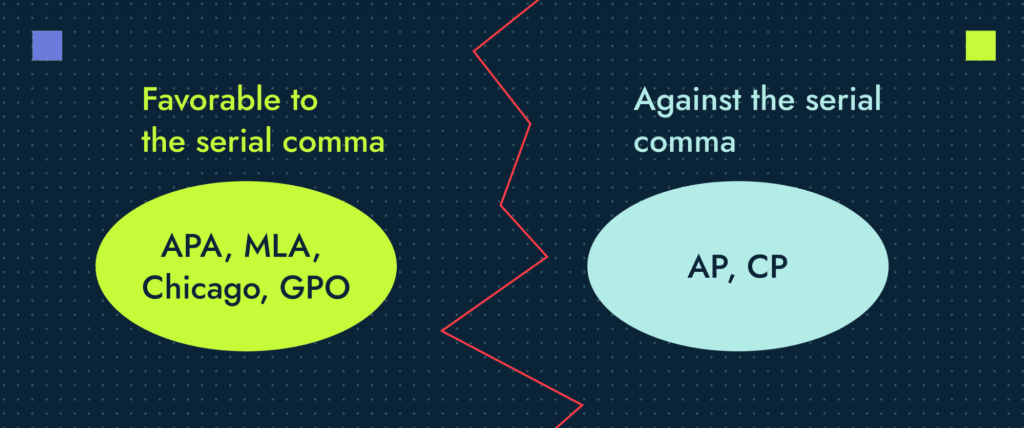
Favorable to the serial comma
- The American Psychological Association (APA), whose style guide is primarily used in fields such as psychology, education, business, nursing and other health sciences.
- The style guide from the Modern Language Association (MLA), which is used in the humanities, particularly in the fields of language, literature and cultural studies.
- The Chicago Manual of Style (CMS), which is widely used in the publishing industry, especially in fields such as history and the classics. This guide is published by the University of Chicago Press.
- The U.S. Government Publishing Office (GPO) Style Manual, which provides guidance to federal agencies for the preparation of official publications.
Against the serial comma
- AP Stylebook, which is the style guide by the news agency Associated Press (AP) and it’s widely used by journalists and news organizations.
- The Canadian Press Stylebook, which is used primarily by journalists and editors at Canadian news organizations, including the Canadian Press news agency, government agencies, and educational institutions in Canada.
Such is the controversy about the use of the Oxford comma that this TED-Ed animation refers to it as the “grammar’s great divide”:
Does B2B marketing content use the serial comma?
There’s a misconception that business writing needs to be rigid and use difficult words to show how eloquent you are. You won’t do well in search engine optimization (SEO) with this approach. Google wants the content to be written by humans for humans, so yes, you can (and should) be conversational.
✍️ Interested in SEO writing? Check out our guide on how to craft search-optimized content.
Being conversational but professional is critical to effective B2B content writing. You want to be approachable but convey authority. Taking a line from our own style guide, “A conversational tone doesn’t mean too casual and full of colloquialisms, slang and interjections.”
The takeaway: You are not required to use the Oxford comma in B2B copywriting, but you should use it if it resonates with your brand’s voice and tone.
Almost two-thirds of our B2B SaaS clients use the Oxford comma
When we look at our portfolio of B2B SaaS clients, 64% use the Oxford comma on their website copy.
All our clients in fintech and life sciences adhere to the Oxford comma because they want to make a more formal usage of language. Last year, one of our clients in the OT cybersecurity industry made a decision to start using the Oxford comma as well. What happened was a change in their leadership team, which also resulted in new product messaging direction and writing style preferences — a case that reinforces the importance of adapting to brand requirements.
Serial comma examples in B2B writing
We’ve put together examples of B2B brands that embrace or omit this controversial punctuation. Let’s start with a fintech company that uses the Oxford comma.

This SaaS company in life sciences also uses the Oxford comma in its website copy.

Next is a cybersecurity company that doesn’t require the use of the Oxford comma in its copy.
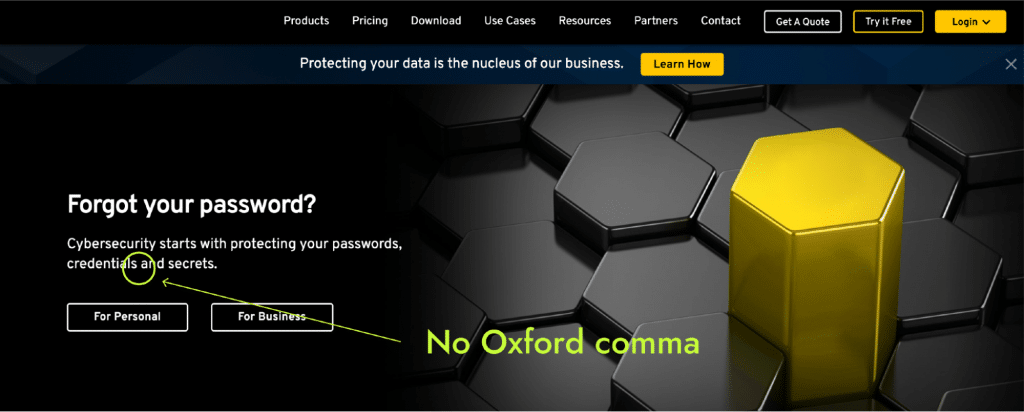
As you might have noticed, Productive Shop doesn’t use the Oxford comma either.
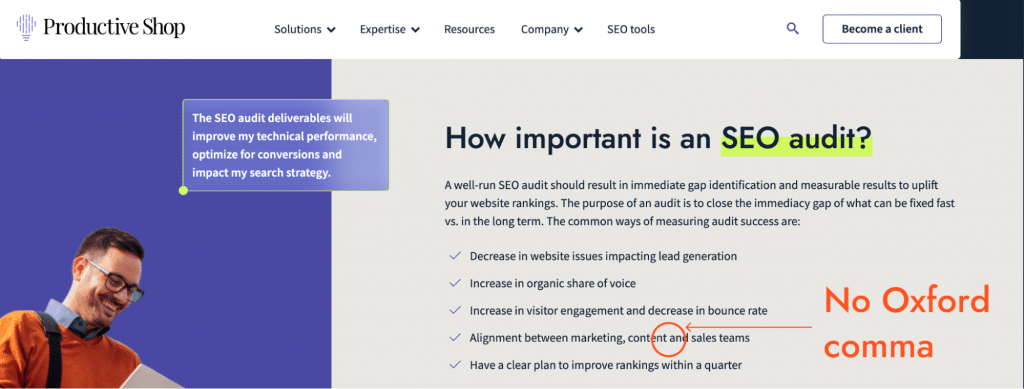
💡If you are going to ditch the Oxford comma, you might want to avoid title cases, too. Title case is when you have all the words in your headlines capitalized. It looks good for short, formal headings, but it’s hard to read in longer titles.
Also keep in mind that style guides that recommend the use of the title case will have specific rules for capitalization (for example, don’t capitalize prepositions, unless they have 4 letters or more). Sentence case – when only the first word or proper nouns are capitalized – is more friendly and easier to read (especially in conversational, actionable titles).
Do writing style preferences impact search engine optimization?
On a recent call with a new client, we were discussing their writing guidelines (for context: they do not use title case and Oxford comma), and they brought up a smart question: does it make any difference in terms of SEO? This question, in fact, was what led me to write this blog post. The short answer is “no.”
You won’t get better or worse results just because you are using specific punctuation or capitalization. However, you should not neglect those details because outputting high-quality content is critical to ranking well in search, and user experience (UX) does matter. Following guidelines for capitalization and punctuation helps to keep the copy consistent throughout your website, so your content doesn’t look sloppy and low quality.
🆘 Need help bulletproofing your copy? Learn how to avoid grammar and spelling errors that can hurt your brand reputation and lead generation efforts.
How to keep up with the Oxford comma
We’ve all been there. If you have to follow different style guides on a daily basis, it can be challenging to keep up with all the unique brand requirements.
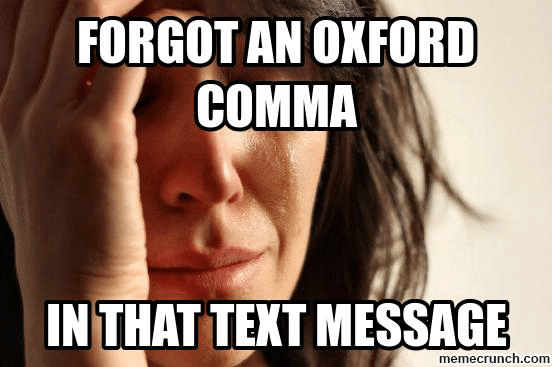
My tip is to have a checklist of content issues (grammar, unique spellings, text formats etc) you have to verify in your drafts. Another piece of advice I give to B2B copywriters in our team is to do a quick search in your doc for “and” and “or.” Every time you find these conjunctions in your copy, you should read the sentence carefully to figure out if it’s the case or not for using a serial comma.
But you should also take advantage of Grammarly. Go to your account and customize your settings. Under Writing Style, you can determine if you want Grammarly to suggest adding the Oxford comma when needed. But keep in mind that if you have a business account, you might need the admin to change the settings.

Ready to build a B2B writing style guide?
Building a content style guide requires a clear grasp of your company’s mission and values, personas and voice. Before making stylistic decisions, you also need a template of what to include (capitalization, hyphenation etc). If you don’t have one or need further guidance on B2B copywriting, give us a shout — and let’s output search-optimized content together. ✍️
Frequently Asked Questions
Why is it called the Oxford comma?
The use of the serial comma has become associated with the Oxford University Press and, as a result, this punctuation came to be known by this name. However, it’s important to note that the use of the serial comma before coordinating conjunctions has a long history in the English language.
When did the Oxford comma become optional?
The use of the Oxford comma was never mandatory, but rather a matter of style preference and editorial discretion.
Does AP Style use Oxford comma?
The Associated Press (AP) Stylebook, a widely-used style guide for journalists and news organizations, says to not use the final comma in a simple series of three or more terms. AP, however, recommends its use when needed for clarity or accuracy.
Does MLA use Oxford comma?
Yes. The Modern Language Association (MLA) is a proponent of the use of commas to separate all items in a series — as a way to avoid ambiguity.
Does APA Style use Oxford comma?
Yes. The American Psychological Association (APA) Style recommends using a serial comma in lists of three or more items separated by the conjunction “and” or “or.” The guide also recommends the use of semicolons instead of commas when one or more items already contain a comma.
Does Chicago Style use Oxford comma?
Yes. The Chicago Manual of Style (CMS) strongly recommends the use of the serial comma to prevent ambiguity.
Do you use an Oxford comma with an ampersand?
The use of the Oxford comma with an ampersand (&) in a list of items is a matter of preference or style guide. For example, the Chicago Manual of Style recommends the use of the Oxford comma but notes that it’s often omitted when the conjunction is the ampersand.



